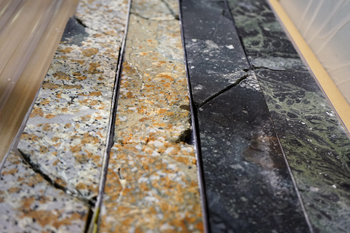These rocks then moved inward toward the impact zone and then up to the surface before collapsing downward and outward again to form the peak ring. All told, the rocks moved about 18.6 miles in a few minutes. In April and May, scientists on an offshore expedition drilled deep into part of the Chicxulub impact crater. Their mission was to retrieve samples from the rocky inner ridges of the crater – known as the “peak ring” – drilling about 1,600 to 4,380 feet below the modern-day sea floor to learn more about the ancient cataclysmic event.
Now, the researchers have performed the first analysis of the core samples. They found that the impact deformed the peak ring rocks, making them more porous and less dense than models had predicted.

Split drill cores collected from the peak ring of Chicxulub crater. The left two cores consist of basement granite. The right two cores are impact melt rocks that were created by the heat associated with the impact. Photo: E. Le Ber
“Chicxulub crater is the only crater on Earth that has such a well-preserved peak ring and since we can't get samples of peak rings from other planets yet, it's really our best window into understanding the formation of large impact basins anywhere in the solar system,” said Sonia Tikoo, an assistant professor in the Department of Earth and Planetary Sciences in the School of Arts and Sciences. “We really didn’t know the exact physical mechanisms behind how peak ring craters form until this study.”

Photo: B. Strauss
Porous rocks provide niches for simple organisms to take hold, and nutrients would also be available in the pores from circulating water that would have been heated inside the Earth’s crust. Early Earth was constantly bombarded by asteroids, and the team has inferred that this bombardment must have also created other rocks with similar physical properties. This may partly explain how life took hold on Earth.
Tikoo has studied the physical properties of the rocks and the granite “basement” that makes up the much of the peak ring. That includes preparing and examining the samples, and making density, porosity and magnetic measurements.
“I have about 400 samples in my lab right now and in the coming months, I’m going to start looking in more detail at the magnetization of these rocks,” she said.
“Magnetism can be used to detect minerals created by impact-related hydrothermal systems,” she said. “You could potentially have hydrothermal systems forming in the Martian crust where you have warm water moving through and we’ve shown that life may be able to exist in those environments here. It’s possible that a similar process could have happened on Mars long ago. It’s another place to look for fossil evidence of life in the past.”




Comments